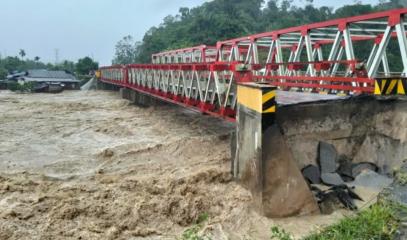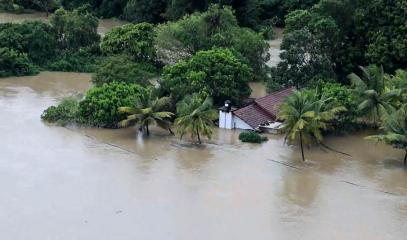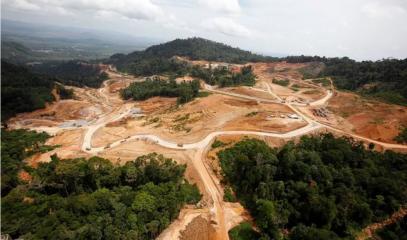Scores die, go missing from weather emergencies causing havoc from Sri Lanka to Indonesia
In Sri Lanka, the preliminary death toll from Typhoon Ditwah stands at 56, with 44,000 people affected. Hundreds of millimetres of rain fell in just a few hours. Government offices and schools are closed. In Indonesia, 19 people are confirmed dead with scores trapped by mud and debris. The archbishop of Medan has launched a fundraiser.
Colombo (AsiaNews) – From Sri Lanka and Indonesia to Malaysia and Thailand, many parts of Asia have been hit recently by extreme weather events that are causing serious damage to infrastructure, not to mention a significant lost in human lives.
In various countries, local authorities have proclaimed a state of emergency, with rescue teams engaged on various places, also thanks to the contribution of NGOs and private organisations, including the Catholic Church, which is helping the population in some areas.
Governments have begun assessing the damage, but evaluations are still incomplete, as a clearer picture of the devastation will only be possible once the worst phase has passed.
In Sri Lanka, the latest death toll stands at 56, with at least 21 missing, and nearly 44,000 people affected in various ways by Ditwah, which morphed from a tropical depression into a cyclone with disastrous effects.
The authorities responded by ordering the closure of many government offices today, except for essential services; high school exams have also been cancelled, while some 20,500 troops are engaged in rescue work. With air travel disrupted, several flights were cancelled or diverted.
The cyclone gained strength over the Bay of Bengal, dropping a record 300 millimetres in Batticaloa and 180 millimetres in Kandi in just a few hours, with more than 200 millimetres expected in numerous other districts on the island.
Sri Lankan President Anura Kumara Dissanayake has already allocated emergency funds and compensation to affected families, but damage estimates are still sketchy, and the most affected areas remain under high alert due to the risk of more flooding and landslides.
Water reservoir levels continue to rise, and dam gates have been opened in several locations, after alerting people downstream to prepare for evacuation due to sudden flooding.
In Kandy, a state of emergency has been declared for the entire district, while national parks in several regions of the island nation have been temporarily closed as a precaution.
The Sri Lankan government has closed all state facilities, while international schools, preschools, and early childhood centres are expected to remain closed until conditions improve.
A preliminary assessment indicates that more than 600,000 acres of agricultural land have been lost to flooding. Analysts now expect prices of vegetables and staple foods to rise in the coming days, with rains expected to continue. Advisories have been issued against travel, at least until the situation improves.
The situation in Indonesia is not much different, particularly in the province of North Sumatra, where at least 2,891 residents in four regencies have been forced to flee flash floods and landslides that have occurred since 24 November, the worst in decades.
Rescue teams continue to deliver aid and assistance to the many affected areas, while the death toll stands at 19 but is likely to rise in the coming days.
According to Indonesia’s National Agency for Disaster Countermeasure (BNPB), the emergency was triggered by a combination of factors: tropical Cyclone Koto in the Sulu Sea, coupled with the effects of Tropical Depression 95B in the Strait of Malacca, with associated rainfall and landslides.
Around 50 people are reportedly trapped in the Hutanabolon area, Central Tapanuli. In a video recorded before communication links were cut, they pleaded for help as the surrounding area was hit by landslides.
The Indonesian Catholic Church has responded to the emergency, as confirmed in a letter sent by Archbishop Kornelius Sipayung of Medan, who asked for contributions to be made to the fundraising campaign launched by local dioceses.
“We have all heard, seen, and read through social media about the natural disasters that have struck the pastoral regions of the Diocese of Sibolga, the Diocese of Padang, and the Archdiocese of Medan,” the prelate said.
“Heavy rains have caused flash floods and landslides, resulting in loss of life and severe damage to homes, rice fields, farms, and various infrastructures.”
In the Archdiocese of Medan, the Catholic Church “stands in solidarity and compassion with our brothers and sisters who are suffering from this disaster,” Archbishop Sipayung stressed.
Given the situation, he calls “upon and direct all the faithful, foundations, institutions, associations, religious congregations, organisations, and individuals within the Archdiocese to take part in providing solidarity assistance to our brothers and sisters affected by the disaster. Material aid such as medicines, basic necessities, clothing, and other supplies can be collected” at various parishes.
(Melani Manel Perera and Mathias Hariyadi contributed to this article)
20/09/2017 14:42
09/10/2021 09:40
23/07/2018 13:18
28/12/2017 09:43










.png)










